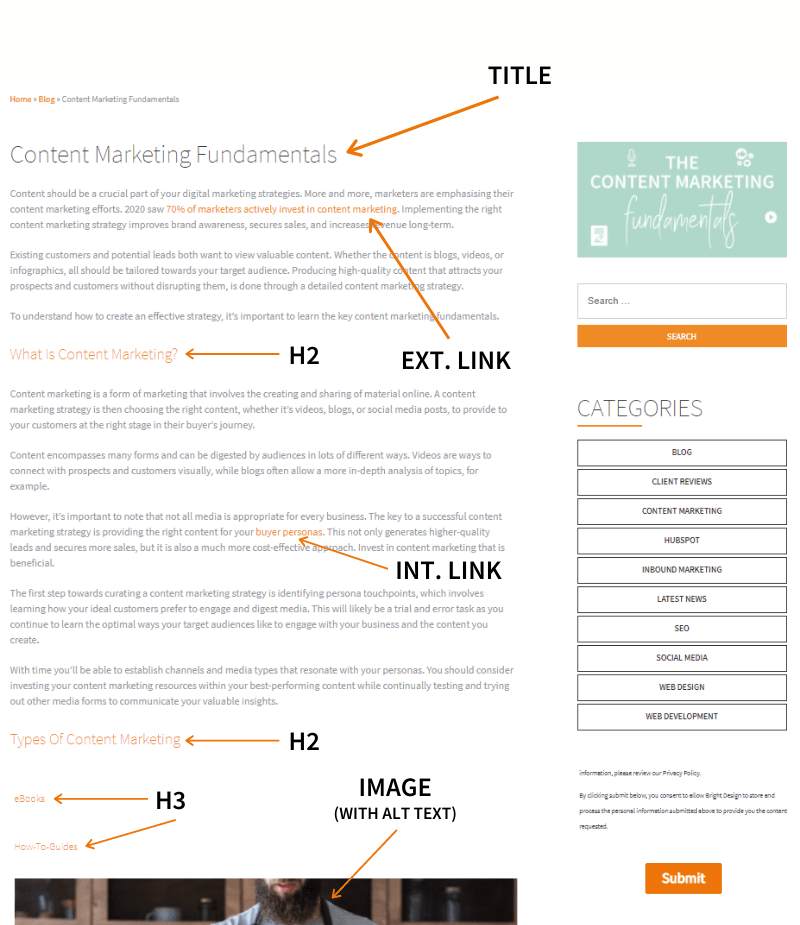Mel is our Partner Strategy & Delivery Manager and also a CIM Chartered Marketer, a testament to her commitment to excellence in the field. But Mel’s contributions don’t stop at the office door. Beyond her professional endeavours, she leads an active life as a qualified run leader and dedicated volunteer. Her experience in these roles has streamlined her leadership and teamwork skills, making her an invaluable asset when it comes to collaborating on projects and ensuring their success. Her sharp insights, strategic thinking, and knowledge have made her a backbone in our team’s ability to drive results for clients in this industry. Mel will make sure that we can approach marketing challenges from all angles and deliver outstanding results for our clients.
Posted on 09/09/2023 by Melanie Comerford
Blogging and SEO - The Perfect Partnership
In the ever-evolving digital landscape, the marriage between blogs and SEO has become a powerhouse for online visibility and success. Research shows that 79% of users are distributing their content via blogs. Understanding how these two elements work in tandem is crucial for anyone seeking to make a mark in the vast online realm.
What is a Blog?
A blog provides a platform to share information, ideas and expertise on specific topics. Businesses use blogs specifically to showcase their knowledge and expertise in a certain industry, however when done correctly these blogs can do so much more. When you produce high quality content, search engines are more likely to recognise and rank your content higher, making it more visible to users who are searching for information on related topics. This will boost website traffic and in turn, send quality leads to your website.
SEO benefits of posting blogs
SEO is predominantly broken down into 3 different types – technical, on-page, and off-page, all of which contribute to building your website’s authority and trust in both the eyes of the search engine and of course, the users.
Google is constantly updating the algorithm to make sure that they keep users satisfied with quality results. One of the most recent updates was focused on content which means it’s more important than ever to make sure your blogs are delivering!
Fresh Content
By regularly updating your blog content on a weekly basis you’re not only providing more great content to your audience but you’re showing search engines like Google that you consistently update and maintain your website. Publishing new blog posts provides fresh material for search engine crawlers to index, signaling that your site is active and relevant.
Targeted keywords and rankings
Integrating relevant keywords into your blog content helps search engines understand the context of your pages. Well optimised content increases the likelihood of ranking higher for specific search queries. When done correctly, blogs can also appear in featured snippets for useful phrases which is something you would want to achieve.
Long-tail keyword opportunities
Blogging allows you to target long-tail keywords—more specific and less competitive phrases. This can attract a niche audience interested in detailed information, enhancing your site’s overall SEO profile.
Internal linking structure
Blogs create opportunities for internal linking, connecting related content within your site. This internal link structure aids in distributing link equity across your pages, improving overall site authority. Make sure you are using anchor text that relates to that other piece of content.
Backlink opportunities
High-quality, informative blog content is more likely to attract external links from other websites. Backlinks from reputable sources are a powerful SEO factor, signaling to search engines that your content is valuable and authoritative. Research found that the number 1 result in Google has an average of 3.8x more backlinks than positions 2-10.
Social Media amplification
Sharing blog posts on social media platforms enhances visibility and drives traffic to your website. While social signals themselves may not be direct ranking factors, increased visibility and engagement can indirectly influence SEO.
Improved user engagement
Engaging and valuable content keeps visitors on your site longer, reducing bounce rates. Search engines interpret longer dwell times and lower bounce rates as signals of user satisfaction, potentially improving your rankings.
Structured data markup
Blog posts offer opportunities to implement structured data markup, providing search engines with additional information about your content. This can result in enhanced rich snippets, making your listings more appealing in SERPs.
Mobile optimisation
As mobile usage continues to rise, search engines prioritise mobile-friendly websites. Blogs that are optimised for mobile devices contribute to a positive user experience, potentially leading to improved search rankings.
Topic authority and expertise
Consistent blogging on specific topics establishes your website as an authority in your niche. Search engines, especially Google, reward expertise by ranking authoritative sites higher in relevant search results. This is where E-E-A-T comes into play.
How do you SEO a blog?
Title and Title Tag
A recent study suggests that title tags are no longer as important as they used to be, however adding your core keyword within the page’s title tag will help users and Google understand what your page is about.
H1, H2, and H3 Headings
These are important for SEO. Most CMS tools like WordPress will try to do this automatically for you but it can sometimes be confusing. Your H1 heading should reflect the title of your blog, however, you should ensure this is a slightly different variation of the page’s title tag. H2s and H3s can be used to break up sections using subheadings, they help provide context to the content on the page.
Length Of Your Content
As a rule of thumb, it’s good to include keywords of terms that are relevant to the topic within the first 100 words. This assures SEs of the relationship between your titles and content. Though not considered to be a ranking factor, you should consider the length of your content too, long-form content tends to perform better in search results due to being more explorative and offering more insights. Basically if you are writing about the topic for the user, it’s likely that you will naturally do this!
Images and Alt-Text
Search engines, unlike humans, do not have the wonders of sight. By using image alt-text to describe the images you include in your content. Search engines will use this text as a relevancy signal, it will also improve the user experience for those who are visually impaired too.
Links
Both external and internal links can help search engines understand the content within your blog. Internal links assist crawlers to identify the relationship between the blog and other related content, improving relevance. External links benefit both search engines and users as it enables them to explore sources of information whilst solidifying the search engines knowledge of what your content is about.
SEO and Content Marketing Solutions at Loop Digital
At Loop Digital we leverage the latest search optimisation techniques to ensure our client partners gain the recognition their businesses deserve. By combining our SEO expertise with our experienced and innovative delivery team we’ve cracked the formula for attaining growth through content. To get started on your journey, book a call with our friendly team who can find the right strategy for you.
Looking for your next opportunity?
Digital marketing careers
We’re always on the lookout for talented individuals to join our ever growing team. If you think you’d be a great match for Loop Digital, we’d love to hear from you.

Join 300+ business owners getting weekly growth strategies - subscribe now.
"*" indicates required fields








